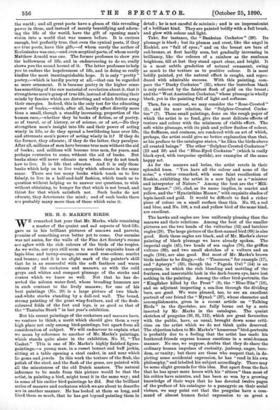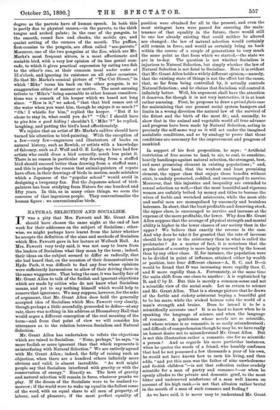MR. H. S. MARKS'S BIRDS.
WE remarked last year that Mr. Marks, while remaining a master of the quaint and sad aspects of bird-life, gave us in his brilliant pictures of macaws and parrots, promise of something even better yet to come. Our surmise was not amiss, for the walls of the Fine Art Society's rooms are aglow with the rich colours of the birds of the tropics. As we write, our eyes still seem to see their exquisite hues of lapis-blue and tawny-orange, cream and rose-colour, scarlet and bronze ; and it is no slight mark of the painter's skill that he is as successful with the soft feathers and warm colours of the cockatoos and macaws, as with the cold greys and whites and compact plumage of the storks and cranes which we know so well. Not that he has de- serted the solemn water-fowl, whose brooding humours are in such contrast to the lively macaws ; for one of his best paintings (No. 20) is a large picture of two black- and-white storks standing by a dull-red wall. The broad, strong painting of the great wing-feathers, and of the flesh- coloured folds of the feet and legs, is as good as that of the " Tantalus Stork " in last year's exhibition.
But his recent paintings of the cockatoos and macaws have, we venture to think, a merit which should give them a very high place not only among bird-paintings, but apart from all consideration of subject. We will endeavour to explain what we mean by reference to another of Mr. Marks's paintings, which stands quite alone in the exhibition, No. 81, " The Casket." This is one of Mr. Marks's highly finished figure- paintings,—a young man, in a russet bonnet and buff jerkin, sitting at a table opening a steel casket, in and near which lie gems and jewels. In this work the texture of the flesh, the polish of the steel, and the flash of the gems, are painted with all the minuteness of the old Dutch masters. The natural inference to be made from this picture would be that the artist, in painting a bird, might treat it in the same way ; and in some of his earlier bird-paintings he did. But the brilliant series of macaws and cockatoos which we are about to describe are in another manner. He has looked at them so long, and liked them so much, that he has got beyond painting them in
detail ; he is not careful de minimis ; and is an impressionist of a brilliant kind. They are painted boldly with a full brush, and glow with colour and light.
Take, for instance, the " Banksian Cockatoo " (29). Its plumage is black ; but its plumes and crest, like the angel in Ezekiel, are "full of eyes ;" and on the breast are bars of red-bronze, at first hardly seen, but gradually increasing in brilliancy, like the colours of a rainbow as the sunbeam brightens, till at last they stand apart clear, and bright. It is a most subtle gradation of natural ornament, owing as much to the texture as to positive colour. It is most boldly painted, yet the natural effect is caught, and repro- duced with admirable success. With this painting, com- pare the "Dusky Cockatoo" (35), where the lustreless black is only relieved by the faintest flush of gold on the breast; and the " West Australian Cockatoo," whose plumage is wholly black, yet in the painting full of light and softness.
Then, for a contrast, we may consider the "Rose-Crested " (2), and its near relation, the " Sulphur-Crested Cocka- too " (7). These small paintings, done on the rough paper of which the artist is so fond, give the most delicate effects of texture and colour with the minimum of visible effort. The soft white plumage, with its pink and yellow flushes of colour, the fluffiness, and cosiness, are rendered with an art of which, perhaps, the artist could give no better explanation than that, as his preface to the catalogue states, " he likes the birds above all created beings." The other "Sulphur-Crested Cockatoos" (23 and 39) and the " Blue-Eyed Cockatoo " (which is really black-eyed, with turquoise eyelids), are examples of the same happy art.
As for the macaws and lories, the artist revels in their splendid hues. " Yon have all the colour and none of the noise," a visitor remarked, with some faint recollection, of Ruskin, exhibiting the artist in a new light as a "minister and interpreter of Nature." Among the best are the "Mili- tary Macaw," (16), clad, as its name implies, in scarlet and yellow, and the " Hyacinthine Macaw," with exquisite shades of lapis-lazuli and gold. It would be difficult to find a richer piece of colour on a small surface than this. No. 93, a red and blue, and No. 108, a red and yellow bird of the same kind, are excellent.
The hawks and eagles are less uniformly pleasing than the macaws and their relations. Among the best of the smaller pictures are the two heads of the vulturine (53) and bateleur eagles (28). The large picture of the first-named bird (89) is also good. Both these eagles are black, and of Mr. Marks's clever painting of black plumage we have already spoken. The imperial eagle (41), two heads of sea eagles (76), the griffon vulture (88), and two small sketches of a vulture and an eagle (104), are also good. But most of Mr. Marks's brown birds incline to be dingy,—the " Tinamons," for example (17), and " Apteryx " (33), though the "Pagoda Owl" (54) is an exception, in which the rich blending and mottling of the feathers, and inscrutable look in the dark-brown eye, have lost nothing in the painting. Among the other bird-portraits, the " Kingfisher killed by the Frost " (8), the " Blue-Tits" (18), and an adjutant inspecting a sea-lion through the dividing bars, are good. We were pleased, too, to see an excellent portrait of our friend the " Mynah " (37), whose character and accomplishments, given in a recent article on " Talking Birds " in the Spectator, are fully borne out by a note inserted by Mr. Marks in the catalogue. The quaint sketches of penguins (26, 85, 112), which are great favourites with the public, have, as usual, brought down some criti- cism on the artist which we do not think quite deserved. The objection taken to Mr. Marks's " humorous "bird-portraits is probably due to a feeling that the artist has made his feathered friends express human emotions in a semi-human manner. No one, we suppose, doubts that they do share the ordinary human impulses of curiosity, jealousy, anger, bore- dom, or vanity ; but there are those who suspect that, in de- picting some accidental expression, he has "read in his own philosophy," and labelled his subject accordingly. There may be some slight grounds for this idea. But apart from the fact that he has spent more hours with his " sitters " than most of his critics have minutes, and has been so won by a growing knowledge of their ways that he has devoted twelve pages of the preface of his catalogue to a panegyric on their social virtues, we may point out that the penguins have a com- mand of almost human facial expression to as great a degree as the parrots have of human speech. In both this is partly due to physical causes,—in the parrots, to the thick tongue and arched palate; in the case of the penguin, to the smooth, round face and cheeks, the mobile eye, and quaint setting of the corners of the mouth. The puffins, first-cousins to the penguin, are often called "sea-parrots." Moreover, one of the two penguins at the Zoo, which are Mr. Marks's most frequent sitters, is a most affectionate and sociable bird, with a very low opinion of its less genial com- rade, to which it gives practical expression by eating two fish to the other's one, at their common meal under water at 12 o'clock, and ignoring its existence on all other occasions. So that Mr. Marks's comical picture of " The Cut Direct," in which Mike' turns his back on the other penguin, is no -exaggeration either of manner or motive. The most amusing tribute to Mike's' being amenable to other human considera- tions was a remark of his keeper which we heard not long since. " How is it," we asked, " that that bird comes out of -the water when you want him, though he enjoys it so much P" " Oh ! I whistle for him," replied the keeper. " But if he -chose to stay in, what could you do P" " Oh ! I should have to give him a good hiding ! shouldn't Mike' P" he replied, laughing, and patting the bird's head affectionately.
We rejoice that an artist of Mr. Marks's calibre should have turned his attention to bird-painting. With the exception of a few—very few—engravers and illustrators of books on natural history, such as Bewick, or artists with a knowledge of falconry, such as J. Wolf and G. E. Lodge, we have had few artists who could draw a bird correctly, much less paint it. There is no reason in particular why drawing from a stuffed bird should succeed better than drawing from a stuffed man; and this is perhaps the reason that animal-painters of repute have often, in their drawings of birds in motion, made mistakes which a Japanese of the "popular school" would avoid in designing a twopenny fan. But the Japanese school of bird- _painters has been studying from Nature for one hundred and fifty years. In this, as in many other things, we seem the converse of that ingenious people. They conventionalise the human figure : we conventionalise birds.







































 Previous page
Previous page